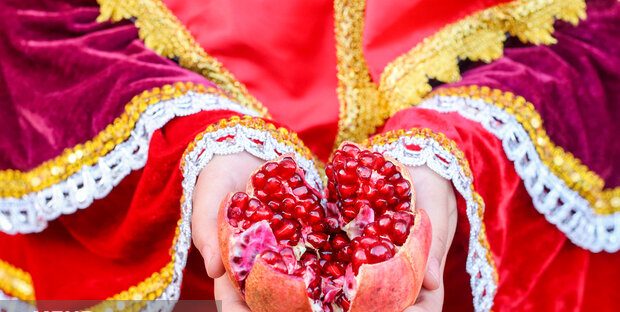WNAM REPORT: From bustling bazaars to festive tables, the pomegranate, or “Anar,” is more than a fruit in Iran; it’s a symbol of tradition, art, and culinary mastery, cherished across generations and celebrated in cities and villages.
In the heart of autumn, as the air turns crisp and leaves paint the streets in shades of amber, Iran celebrates a fruit that has woven itself into the very fabric of its culture: the pomegranate. Known as “Anar” in Persian, this small, ruby-red treasure is more than just a fruit, it is a symbol of abundance, beauty, and tradition, cherished across generations and regions of the country. Every October, families, markets, and festivals pay homage to its presence, filling homes with its scent and color.
Walking through local bazaars on this day, one can feel the pulse of history and culture intertwined in every stall. Farmers display glistening pomegranates harvested from orchards in different parts of the country, while vendors share stories of ancient cultivation methods passed down through centuries. The fruit’s delicate seeds, encased in a leathery crimson shell, have long inspired poets, artists, and chefs alike, appearing in literature, painting, and culinary traditions as a reminder of life’s sweetness and resilience.
Beyond their beauty, these fruits underpin local livelihoods, global trade and a surprising array of modern science, from cancer diagnostics to eco-friendly pest control. This report traces Iran’s pomegranate from orchard to table, revealing how an ancient fruit is shaping a modern nation.”
The Cultural and Literary Significance of the Pomegranate in Iran
The pomegranate has held a special place in Iranian culture for centuries, appearing in rituals, celebrations, and daily life as a symbol of fertility, prosperity, and divine blessing. From traditional weddings to Yalda Night (the longest night of the year), it is often present on tables, its seeds representing life, abundance, and the promise of renewal. In rural villages, it is common to see families carefully harvesting the fruit together, preserving a tradition that links generations through both work and celebration.
In Persian literature, the pomegranate is much more than a fruit; it is a poetic emblem. Classical poets such as Hafez and Saadi frequently referenced the pomegranate’s vivid red seeds and its sweet, tangy juice as metaphors for love, beauty, and the hidden treasures of the human heart. It is also a recurrent motif in Persian miniature paintings and storytelling, representing hidden depth, vitality, and the interconnectedness of nature and human emotion. The imagery of opening a pomegranate to reveal its countless seeds mirrors the literary exploration of life’s many layers, making it a favored symbol across centuries of Persian art and letters.
Pomegranate in Iranian Cuisine
In Iranian kitchens, pomegranate is more than just a seasonal fruit—it is a symbol of flavor, color, and tradition. Its tangy-sweet taste and jewel-like seeds enrich a wide range of dishes, bringing both visual appeal and cultural significance to every meal. From everyday family tables to festive gatherings, pomegranate’s presence reflects Iran’s deep culinary heritage.
One of the most beloved uses of pomegranate is in Fesenjan, a slow-cooked stew made with walnuts and pomegranate molasses. The rich, nutty base combined with the tangy sweetness of pomegranate creates a complex and memorable flavor, traditionally served with duck, chicken, or meatballs.Another classic dish is Zeytoon Parvardeh (marinated olives with pomegranate), a popular appetizer in northern Iran. This dish mixes olives with pomegranate seeds, pomegranate paste, walnuts, and herbs, offering a perfect balance of sour, sweet, and savory notes.
Pomegranate also finds its way into salads, rice dishes, and sauces. Its seeds add a burst of freshness and color, while pomegranate juice or molasses enhances the depth of stews and condiments. Whether used in a festive dish like Fesenjan or a simple table appetizer like Zeytoon Parvardeh, the fruit’s versatility and vibrant flavor make it an essential part of Iranian cuisine, blending taste with centuries of tradition.
Pomegranate in Iranian Handicrafts
The influence of pomegranate in Iran goes far beyond the kitchen. Its distinctive shape, vibrant red color, and symbolic meaning have inspired generations of Iranian artisans, appearing in a wide variety of traditional handicrafts. From miniature paintings and pottery to textiles and metalwork, the pomegranate often serves as a motif of fertility, abundance, and beauty.
In Persian miniature art, pomegranates are depicted in garden scenes, wedding celebrations, and festive gatherings, emphasizing the fruit’s cultural significance. Similarly, in ceramics and pottery, artisans paint or carve pomegranates onto vases, plates, and decorative tiles, blending natural elegance with artistic craftsmanship. These pieces often showcase intricate patterns, reflecting both the form of the fruit and the cultural narratives surrounding it.
Textiles also bear the mark of the pomegranate motif. In Persian carpets and embroidery, pomegranates appear as repeating patterns or central symbols, symbolizing prosperity and life. Jewelry makers incorporate pomegranate shapes into pendants and charms, preserving the fruit’s symbolism in wearable art. Across these crafts, the pomegranate is more than decoration, it embodies centuries of cultural identity, connecting everyday life to the richness of Iranian heritage.


